Asian Development Outlook (ADO) 2022 Supplement: Global Gloom Dims Asian ProspectsSouth Asia is projected to grow at 6.5% in fiscal year (FY) 2022 and 6.3% in FY2023. In Bangladesh, weak exports and high inflation are hampering recovery, while in Bhutan, agriculture and construction are projected to support economic growth. In India, growth is projected at 7.0% in FY2022 and 7.2% in FY2023, sustained by public reform and public and private investment. Maldives tourist arrivals and construction continue to pick up. In Nepal, the 2023 budget aims to improve agriculture, industry, and social protection. Economic contraction is expected in Sri Lanka with marked declines in industry and agriculture. In Southeast Asia, Myanmar maintains positive growth projections despite high rates of inflation. Author: Asian Development Bank Year: 2022 Download Tags: ADB, Agriculture, South Asia, Southeast Asia, Investment, Social Protection Asian Development Outlook (ADO) 2019 Supplement, December: Growth Slows Further in Developing Asia’s GiantsDeveloping Asia's gross domestic product is projected to grow by 5.2% both in 2019 and 2020 as a slowing of global economic activity tempers regional growth, according to the Asian Development Outlook (ADO) 2019 Supplement. In South Asia, growth forecasts have been lowered to 6.1% in 2020. Strong remittances in Bangladesh will raise domestic demand, while in Bhutan, hydropower production rose to 3.1% in Q1 of FY2020 (ending 30 June 2020). Growth in India is expected to recover to 6.5% in 2020 with government policy measures, such as a corporate tax cutt and policy rate reduction. In Maldives, tourism remains strong. Foreign direct investments surged in Nepal while a recovery in economic activity is projected in Sri Lanka. Author: Asian Development Bank Year: 2019 Download Tags: ADB, South Asia, Hydropower, Tourism, Investment, Bangladesh, Bhutan, Maldives, Nepal, Sri Lanka World Bank East Asia and Pacific Economic Update, October 2019: Weathering Growing RisksAmid weakening global demand and policy uncertainty regarding trade tensions, growth in developing East Asia and Pacific region slowed in the first half of 2019. There is a need to address vulnerabilities and preserve economic dynamism in developing economies in the region. In Myanmar, GDP growth will reach 6.8% in 2021/2022 with the projected pick-up in agriculture. Policy measures to encourage investment, such as those for the energy sector, are expected to strengthen Myanmar’s manufacturing and construction sectors. Author: World Bank Year: 2019 Download Tags: Energy, Investment, Myanmar, WB South Asia: Shifting Outlook Calls For Steadfast ReformsGrowth in South Asia is projected to rise to 7.0% in 2020. To create more and better jobs, the region needs to further strengthen reforms. Growth in Bangladesh is expected to remain strong at around 8.0% in fiscal year (FY) 2019, led by private consumption and investment. In Bhutan, economic activity will pick up to around 6.0% in FY2020, supported by private consumption. In India, gross domestic product (GDP) growth slowed to 6.8% in FY2018/2019. Economic activity in Nepal remains robust as FY2018/2019 growth reached 7.1%. In Maldives, growth has been supported by increasing tourist arrivals. Economic activity in Sri Lanka is projected to recover as the tourism sector stabilizes. Author: International Monetary Fund Year: 2019 Download Tags: Bangladesh, Bhutan, India, Maldives, Nepal, Sri Lanka, Investment, Jobs, Tourism World Investment Report 2019This report monitors global and regional foreign direct investment trends and national and international investment policy developments. Foreign direct investments (FDI) in South Asia grew by 4% in 2018 to $54 billion, with India accounting for $42 billion. International cooperation in the development of special economic zones (SEZs) has been increasing. In developing countries, many SEZs are built through bilateral partnerships or as part of development cooperation programs. In South Asia, the number of SEZs is set to increase substantially. India has 200 new zones in the pipeline, while Bangladesh has 60, and Nepal 12. Author: United Nations Conference on Trade and Development Year: 2019 Download Tags: Bangladesh, India, Nepal, FDI, Investment, South Asia, UNCTAD World Investment Report 2018In India, foreign direct investment (FDI) inflows dropped from $44 billion in 2016 to $40 billion in 2017. Across South Asia, FDI inflows are predicted to stagnate or decline marginally in 2018. The global trend in FDI flows demonstrates the need for open, transparent, and non-discriminatory investment policies to maintain an environment conducive for investment. New types of industrial policies are emerging to respond to opportunities and challenges brought about by a new industrial revolution. This report examines investment policy tools available in the new environment. Author: United Nations Conference on Trade and Development Year: 2018 Download Tags: Connectivity, FDI, Global Value Chains, India, Investment, Policy, Sustainable Development Goals, South Asia, UNCTAD Transport Corridors and their Wider Economic Benefits: A Critical Review of the LiteratureThis paper reviews literature estimating the impact of large transport investments. It reviews 78 studies, 11 of which centers on infrastructure projects in India. The paper looks at the economic benefits of transport infrastructure projects to better understand how corridors could generate wider economic benefits, with a focus on roads, rails, and waterways. The review assesses the impact of transport corridor projects on economic welfare and equity, environmental quality, and social inclusion, and suggests a need for policies and institutions that address trade-offs. Author: Mark Roberts, Martin Melecky, Theophile Bougna, and Yan Sarah Xu Year: 2018 Download Tags: Economic Corridor Development, India, Infrastructure, Investment, Railway, Roads, Transport, WB Asia-Pacific Trade and Investment Report 2017: Channelling Trade and Investment into Sustainable DevelopmentThis report provides analyses of trends and policy developments in trade in goods and commercial services in Asia-Pacific. It shows that merchandise trade remained subdued in 2016, with South and Southwest Asia accounting for 8% of Asia-Pacific exports and 12% of Asia-Pacific imports. Foreign direct investments inflows In South and South-West Asia decreased slightly by 4% to $66 billion in 2016. The report also argues for targeted trade and investment policies that strike a balance between economic development and social and environmental development. Author: United Nations Economic and Social Commission for Asia and the Pacific Year: 2017 Download Tags: Trade, Investment, FDI, ASEAN, India, Services, South Asia, Sri Lanka, Sustainable Development Goals, UNESCAP Transport Policies and DevelopmentThis survey reviews the current state of impact assessment of transport investments and policies on growth, inclusion, and sustainability in a developing country context. It reviews the cost and benefits of transport investment and policies in developed countries and discusses challenges in implementing transport interventions in developing countries. Author: Claudia N. Berg, Uwe Deichmann, Yishen Liu, and Harris Selod Year: 2017 Download Tags: Investment, Sustainability, Transport Myanmar’s Integration with the WorldMyanmar only recently began participating in global trade and investment. It has large untapped potential for trade and investment in agriculture and forest-based industries, and services, such as tourism and information technology. This book examines Myanmar’s access to the global market and examines the implication of Myanmar’s democratic transition, the progress of Myanmar’s industry and infrastructure, its international linkages, and options for increased integration in regional economic groups. The book also analyzes how Myanmar could exploit global value chains. Author: Prabir De and Ajitava Raychaudhuri, editors Year: 2017 Download Tags: Agriculture, Global Value Chains, Infrastructure, Investment, ICT, Myanmar, Regional Integration, Trade World Investment Report 2017This report presents foreign direct investment (FDI) trends and prospects at global, regional and national levels. FDI flows to developing Asia contracted by 15% to $443 billion in 2016. This decline was relatively widespread, except in South Asia, where several countries including Bangladesh and Nepal are expected to receive more FDI in the coming years. The report investigates the internationalization patterns of digital multinational enterprises, as well as the effect of digitalization on global companies across all industries. It provides insights to policymakers on how the digital economy impacts investment policies and how investment policy can support digital development, with a view toward achieving the SDGs. Author: United Nations Conference on Trade and Development Year: 2017 Download Tags: FDI, Global Value Chains, Investment, Policy, South Asia, UNCTAD, Bangladesh, India, Nepal 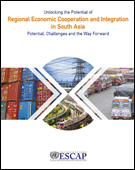 Unlocking the Potential of Regional Economic Cooperation and Integration in South AsiaAt a modest 6% of total trade, intraregional trade in South Asia stands at less than one third of its full potential. Trade barriers and inadequate infrastructure have cost South Asia over US $54 billion per year in lost export opportunities. With 309 million people living on less than $1.90 a day—the largest concentration of poverty in the world—South Asia should urgently pursue broad-based regional economic cooperation that could enable effective responses to the subregion’s developmental challenges. This report examines the state of economic integration in South Asia and identifies potential areas for further strengthening subregional linkages. It provides recommendations on policy actions to increase market integration, improve connectivity, boost investment in infrastructure development, and tackle shared vulnerabilities and risks. It calls for the consolidation and upgrading of existing trade and investment cooperation initiatives into a South Asia Comprehensive Economic Partnership. Author: United Nations Economic and Social Commission for Asia and the Pacific Year: 2017 Download Tags: BIMSTEC, Investment, Regional Cooperation, SAARC, South Asia, Sustainability, Sustainable Development, Trade, UNESCAP, Bangladesh, Bhutan, India, Maldives, Myanmar, Nepal, Sri Lanka Climbing Higher: toward a Middle-income NepalNepal is experiencing modest growth but brisk poverty reduction. It has halved the poverty rate in just seven years and witnessed an equally significant decline in income inequality. Yet Nepal remains one of the poorest and slowest-growing economies in Asia, with per capita income falling behind its regional neighbors. The report discusses the need for comprehensive policy reform to address the country’s challenges in becoming a lower-middle-income country by 2030. The report outlines suggested reforms to facilitate greater investment and improved productivity, build new sources of growth, and deepen human capital. Author: World Bank Group Year: 2017 Download Tags: Employment, Investment, Nepal, Poverty Reduction, Trade, Transport, WB Capital Market Integration in South AsiaThis book discusses the potential capital market products and activities within South Asia that stakeholders in the region could explore to help the South Asian Association for Regional Cooperation (SAARC) region further realize its potential. Conventional investment, such as funds, global depository receipts, as well as promising opportunities that factor the region's demographics and socioeonomics are considered in this book, with arguments aimed toward investors and institutions. The book demonstrates both retail and institutional investor interest in this combined high-growth region by offering scope for yield, diversification and risk mitigation, maximized upside from multiple growth markets, minimized downside through low-correlation constituents, and makes the case why now is an opportune time to look at SAARC. Author: Sourajit Aiyer Year: 2016 Download Tags: Investment, SAARC, Trade, Economic Corridor Competitiveness of South Asia’s Container Ports: A Comprehensive Assessment of Performance, Drivers, and CostsAs a result of inefficiencies in South Asia’s container ports, the average cost of exporting or importing a container in the region is more than double that in East Asia. Better port logistics could help increase trade, diversify exports, attract more foreign direct investment, and spur economic growth. As container traffic continues to grow in South Asia, the best way to improve port performance is by increasing productivity. This report examines the performance of the 14 largest container ports in the region, identifying key drivers of port performance and examining differences in performance across ports. Author: Matías Herrera Dappe and Ancor Suárez-Alemán Year: 2016 Download Tags: Customs, Economic Growth, FDI, Infrastructure, Investment, South Asia, Trade, WB South Asia Economic Focus, Fall 2016: Investment Reality CheckSouth Asia continues on a path of gradual acceleration in 2016, led by a solid India. However, amid the resilience to external headwinds, including China’s slowdown and uncertainty surrounding monetary policy in advanced economies, South Asia is starting to feel the effect of slowing remittance flows or waning oil price dividends. Against this backdrop, this World Bank publication forecasts growth for the region at 7.1% in 2016, with its medium-term performance strongly dependent on investment and export turnout. India is set to grow at 7.6% in 2016, with the same speed as in 2015, but may increase its pace again in 2017 to 7.7%. The report highlights how private investment is a key future growth driver across South Asia that could help further boost the pace of economic activity. Author: World Bank Year: 2016 Download Tags: India, South Asia, Investment, Economic Growth, WB, Export Nepal Investment Guide 2016Nepal Investment Guide 2016 was published to provide information about investment opportunities in Nepal and the process of doing business. It identifies potential sectors for investment; relevant government agencies for foreign businesses; existing laws on labor, taxation, and imports and exports; special economic zones; and comparative benefits to investors. Author: Nepal Office of the Investment Board Year: 2016 Download Tags: Nepal, Import, Export, Investment SAARC: The Way AheadThis Observer Research Foundation Issue Brief examines the South Asia Association for Regional Cooperation as a regional grouping that is almost three decades old. It discusses trade arrangements such as the South Asian Preferential Trading Arrangement aimed towards a higher level of intraregional trade liberalization and economic cooperation, including the South Asia Free Trade Area for reduction of Customs duties on traded goods. The paper further studies areas of energy, connectivity, foreign direct investment, trade in services and subregional cooperation. The South Asia Subregional Economic Cooperation Program is offered as one of the steps in the direction of having a viable option for subregional cooperation. Author: Jayshree Sengupta Year: 2015 Download Tags: Regional Cooperation, SAARC, Trade, Connectivity, Energy, FDI, Investment, Free Trade Agreements, Services, South Asia 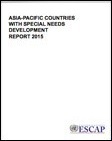 Asia-Pacific Countries with Special Needs Development Report 2015In the Asia-Pacific region, 36 out of the 58 economies are considered countries with special needs (CSN), which include least developed countries (LDC), landlocked developing countries, and small island developing States. This report highlights important areas that should be addressed as key priorities by CSNs such as economic diversification, external trade, South-South cooperation, and official development assistance including foreign direct investment. Bhutan and Nepal met the criteria for graduation from LDC status as of 2013. Other countries such as Bangladesh have a good chance of meeting the graduation criteria by 2018. Among the Small island developing States, Maldives is considered a success story in broadband internet connectivity. The results of this research show that Asia-Pacific CSNs must choose their paths to diversification carefully, depending on country circumstances. Author: United Nations Economic and Social Commission for Asia and the Pacific Year: 2015 Download Tags: Asia-Pacific, Least Developed Countries, Small Island Developing States, Bangladesh, Bhutan, Energy, FDI, Investment, Maldives, Nepal, Trade, Transport, UNESCAP Impact of Trade Facilitation on Foreign Direct InvestmentThis United Nations Economic and Social Commission for Asia and the Pacific Trade and Investment Working Paper attempts to quantify the potential impact of trade facilitation on foreign direct investment (FDI) flows. The study uses bilateral FDI data from 2006 onward from both developing and developed countries, including South-South FDI flows, wherein contiguity (common border between source and host country) and geographic distance are found to be much more important factors. In applying an augmented FDI model framework to determine the effect of comprehensive international trade costs, the results show that both non-tariff and tariff costs are important determinants of FDI inflows. Author: Yann Duval and Chorthip Utoktham Year: 2014 Download Tags: FDI, Trade Facilitation, Bilateral Trade, UNESCAP, Investment, Tariff, Bangladesh, Maldives ASEAN, PRC, and India: The Great TransformationThis joint study by the Asian Development Bank and the Asian Development Bank Institute highlights the Association of Southeast Asian Nations, the People’s Republic of China, and India (collectively referred to as ACI economies) as drivers of the global economy. It explores links among ACI economies and how these may shape regional and global competition and cooperation. The study also notes that Asia’s leading economies can foster a positive outcome through a paradigm shift toward inclusive, green, and knowledge-led growth. Adoption of low-carbon, green growth strategies can help place ACI economies on a sustainable growth path. Furthermore, infrastructure and human capital investments can link ACI economies through region-wide free trade and investment agreements. Author: Asian Development Bank and Asian Development Bank Institute Year: 2014 Download Tags: India, Asia-Pacific, Regional Cooperation, ADB, ASEAN, Investment 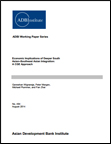 Economic Implications of Deeper South Asian–Southeast Asian Integration: A CGE ApproachHigh tariff and non-tariff barriers, and costly transport links and inefficient trade facilitation measures continue to hamper the growth of trade between South Asia and Southeast Asia. This paper explores whether potential gains from improved connectivity—via Myanmar as inter-regional bridge—justify a high level of investment. Using an advanced computable general equilibrium (CGE) model, reduction of inter-regional tariffs, decreasing of non-tariff barriers by 50%, and cutting down of trade costs between South Asia and Southeast Asia by 15% yields a prediction of 8.9% rise in welfare in South Asia and Southeast Asia, and an increase of 6.4% in gross domestic product by 2030. Author: Ganeshan Wignaraja, Peter Morgan, Michael Plummer, and Fan Zhai Year: 2014 Download Tags: Transport, Trade Facilitation, South Asia, Southeast Asia, Regional Integration, Tariff, Trade, Connectivity, Investment, Myanmar, GDP Opportunity Cost of Natural Gas Subsidies in BangladeshThis paper examines the impact of optimal gas pricing policy using a general equilibrium model for the Bangladesh economy. It estimates the opportunity cost of underpricing or subsidizing gas in Bangladesh. It further explores the potential impacts of an increase in investment on social and physical infrastructure using the social accounting matrix multiplier model. The results reveal that Bangladesh is losing a significant development opportunity due to its gas subsidy. Calculations using a dynamic computable general equilibrium model suggest that withdrawal of the gas subsidy along with increased investments in physical and social infrastructure would lead to positive macroeconomic and sectoral effects in Bangladesh. Author: Herath Gunatilake and Selim Raihan Year: 2014 Download Tags: Bangladesh, Energy, ADB, Investment 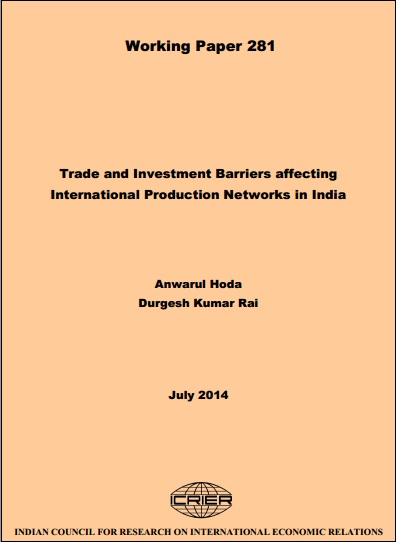 Trade and Investment Barriers Affecting International Production Networks in IndiaRecognizing India as an outlier in development of international production networks with the lowest participation among Asian countries, this study investigates the reason for India’s lackluster participation in production-sharing networks. Using desk work, field surveys, and interviews, an analysis is adopted with three comparator countries in the region that have been successful in production-sharing arrangements as well as industrial growth – China, Malaysia, and Thailand. It further describes foreign direct investment inflows into India, analyzes behind-the-border investment environment, and provides recommendations to improve investment climate and hasten the pace of manufacturing development in India. Author: Anwarul Hoda and Durgesh Kumar Rai Year: 2014 Download Tags: India, Trade, Production Networks, Investment, Thailand, Manufacturing, Customs, Economic Corridor, Energy, Trade Facilitation, Transport SAARC Biz: The Inevitability of South Asia SAARC Biz is a monthly publication of the SAARC Chamber of Commerce & Industry and features a report on the 'Inevitability of South Asia'. While the term 'South Asia' is commonly accepted, it argues that regionalism is far from being implemented on the ground. For instance, SAARC was accepted as a concept of cross-border regionalism but was hobbled due to budget constraints and restrictive mandates. Connectivity across national frontiers is needed to jump-start regionalism and improve lives in the most deprived parts of the Subcontinent. Author: SAARC Chamber of Commerce and Industry Year: 2014 Download Tags: South Asia, Regional Cooperation, SAARC, Industrialization, Regional Integration, Poverty Reduction, Gender, Least Developed Countries, Connectivity, Agriculture, Bangladesh, Youth, India, Environment, Investment, Tourism, Renewables 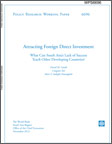 Attracting Foreign Direct Investment: What Can South Asia's Lack of Success Teach other Developing Countries?Despite South Asian nations experiencing increased foreign direct investment (FDI) flows over the past decade by gaining a large share of cross border investments, FDI inflows in South Asian countries still remain the lowest relative to gross domestic product (GDP) among developing country regions. This paper uses an empirical model that accounts for possible trends in convergence in the ratio of FDI to GDP between countries and cross-sectional data for 78 countries from 2000 to 2011. In examining the historical patterns of South Asia’s FDI and its connection with the policy environment, policymakers can identify constraints to FDI and boost potential for broad-based growth. Author: David M. Gould, Congyan Tan and Amir S. Sadeghi Emamgholi Year: 2013 Download Tags: South Asia, Trade Policy, FDI, GDP, Investment, Governance, Transparency, Economic Growth, Financial Sector, Regional Cooperation, Trade |



